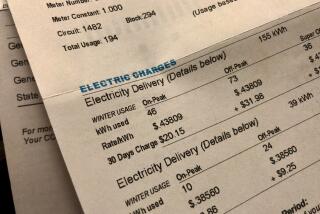Deregulation of Phones Stirs Hornet’s Nest
- Share via
WASHINGTON — Deregulation and competition lead to more choices and lower prices for consumers, or so says the free-market ideology that drives American economic policy.
But when it comes to the contentious, complicated telephone industry, nothing is ever that simple. When government regulators next week take the wraps off rules designed to overhaul decades of telephone subsidies, consumers are unlikely to see anything like the kind of savings that resulted from deregulation in other industries such as trucking and airlines.
Instead--whether by direct federal action or subsequent decisions by state regulators--the average $20 monthly phone bill for basic residential service is expected to climb as much as 30%; business rates will climb higher still. And while long-distance rates will fall, it isn’t clear just how much.
The expected price hikes stem from a massive and controversial effort by the Federal Communications Commission and state public utility commissions to redesign a system that for years has enabled millions of Americans to get local phone service for less than it costs carriers to provide it.
Simply stated, the goal is to reduce the local-service subsidies that are currently built into business phone rates, long-distance phone charges and special services such as call waiting and voice mail, while still assuring that basic phone service remains affordable for the poor and those in high-cost rural areas. The various subsidies raise about $23 billion annually.
Preserving “universal service,” as it’s known in phone parlance, has become a contentious political issue, pitting rural locales against cities, businesses against residential users and the well-off against the poor.
The FCC remains bitterly divided over how to proceed. Commissioners James H. Quello and Rachelle Chong are in favor of aggressive cuts in access charges, while Chairman Reed E. Hundt is in favor of a more “revenue neutral” approach and commissioner Susan Ness is still undecided on key issues. The debate is further clouded by the Clinton administration’s insistence that the FCC deliver some sort of rate cuts for all consumers and businesses.
“The administration does not believe Congress wanted Americans to end up paying more for telephone service, and that is not what the administration wants,” said Larry Irving, the Commerce Department’s assistant secretary of information and communications.
*
FCC officials say there is agreement on the need to trim the $14 billion in annual fees long-distance carriers pay local phone companies--perhaps by 10% to 20%. But the agency is undecided about a controversial FCC proposal to raise from $3.50 to $6.00 the subscriber line charge for second residential phone lines, which have become a popular way for residential users to telecommute or access the Internet.
Hundt and other FCC officials have acknowledged that including such a charge would raise phone bills for some residential users, and the proposed measure is furiously opposed by computer and Internet companies.
Predictably, long-distance and local phone carriers are also at odds on most aspects of the proposed reform--and especially the $14 billion in access charges. Local phone carriers such as Pacific Bell want to cut the subsidies as slowly as possible, since they collect and manage the huge pot of money and use it to keep rates low for their customers.
Long-distance carriers like MCI, by contrast, claim the long-distance industry pays $10 billion a year too much in access fees. Experts agree the charges are excessive, but it remains to be seen whether any price cuts would trickle down to consumers or simply fatten the bottom line of long-distance carriers.
“We are talking about huge transfers of wealth,” said Edward L. Hudgins, director of regulatory studies at the CATO Institute, a Washington think tank. “This is very different from most previous efforts at deregulation. The government is deciding what users will fall into a privileged class [that will received subsidies] and what users will not be part of that class.”
“If the FCC does, as I think it should, reduce the long-distance access charge, it has to increase” other local phone service charges to keep phone service affordable for everyone, said Alfred E. Kahn, an economist and former chairman of the now defunct Civil Aeronautic Board. “I don’t doubt for one minute that residential bills will go up, particularly for people who don’t make many long-distance calls.”
Besides the challenge of keeping phone service affordable, the new telecommunications reform law passed last year requires the FCC to give schools, libraries and rural health-care facilities high-speed access to the Internet at steeply discounted rates.
Some experts say that effort could cost more than $20 billion over the next decade. But a federal-state panel that has studied the issue has recommended that the FCC cap any subsidy for schools, libraries and rural health-care providers at $2.25 billion a year.
Government officials acknowledge that trying to please everyone while raising the huge amounts of money needed to keep phone service affordable will be difficult. It is complicated by the fact that government officials are undertaking the task before real telephone competition exists in local markets.
“We don’t have fully competitive markets, so we can’t say with precision what are the forward-looking costs,” said Tom A. Boasberg, legal advisor to FCC Chairman Hundt. “But we want to move to a system where, gradually, over time, consumers pay the actual cost” of using the telephone network.
Determining “actual costs” for particular services, though, is itself almost impossible in a business where an integrated phone network, developed gradually over many years, provides a wide range of services.
Since last fall, the FCC has conducted studies to determine the effects of competition on phone pricing. But the agency claims neither its findings nor industry estimates are reliable enough to accurately predict the cost of universal service. That has fueled speculation that the FCC may delay ordering specific subsidy levels for a year or more and only approve general service rules.
But Hundt denied his agency would sidestep the contentious issue.
*
Even so, new technology and changing markets could upset the best calculations. Some experts, for example, believe that the fast-growing wireless industry could drive down the cost of providing phone service, especially in costly-to-wire rural markets.
Competition among existing wireless providers has already spawned dialing rates as low as 3 cents a minute in some markets. And AT&T; is testing a wireless system that will connect homes to an AT&T; digital switching center via a neighborhood antenna mounted on a utility pole or other structure.
But technology alone won’t resolve all of the FCC’s regulatory woes. The agency faces criticism for maintaining a system that awards subsidies to rural telephone markets without regard to income. Many critics say the telephone industry is wasting millions of dollars subsidizing phone service for people who could afford to pay their own way.
“To this day I’ve never understood why the impoverished communities of Vail and Aspen are entitled to [phone] subsidies,” Sen. John McCain, chairman of the Senate Commerce Committee, said in a sarcastic swipe at the two tony Colorado ski resort towns, which qualify for subsidies because they are deemed rural areas.
But supporters say telephone subsidies have enabled the United States to become one of the best-connected nations in the world, with more than 90% of all American households having telephone service. They say in an age in which communications networks are even more central to the economy, democratic discourse and as a lifeline to doctors, police and firefighters, it is critical that the government ensure that those in costly-to-serve communities have affordable phone service.
Earlier this month, for instance, senators representing the rural states of North Dakota and Nebraska threatened to block White House efforts to fill vacancies at the FCC unless the Clinton administration finds a candidate sympathetic to rural telecommunications interests.
In an attempt at compromise, industry giants AT&T;, Bell Atlantic and Nynex earlier this month proposed a plan they said would slash long-distance access fees by $2.5 billion, cut monthly phone bills for business and residential users by $400 million annually and still keep local phone service affordable for rural and low-income customers, while providing $1.4 billion to wire the nation’s schools, libraries and rural health-care facilities for high-speed Internet access.
But the proposal was denounced by Hundt, consumers and rival local and long-distance carriers, who claimed it did not go far enough to spread the burden for industry support of universal service and benefited carriers serving the densely populated northeastern region at the expense of carriers serving more sparsely populated regions.
*
Given the continued bickering over universal service, experts aren’t optimistic that consumers can be spared a significant rate hike.
“There is no reason, given the excess fat in the system, for any consumer to pay rate increases,” said Gene Kimmelman, co-director of Consumers Union’s Washington office. “But in the end, there is a great danger that . . . consumers will see bloated, excess rates because regulators may not have the courage to take on the well-financed telephone industry lobby.”






